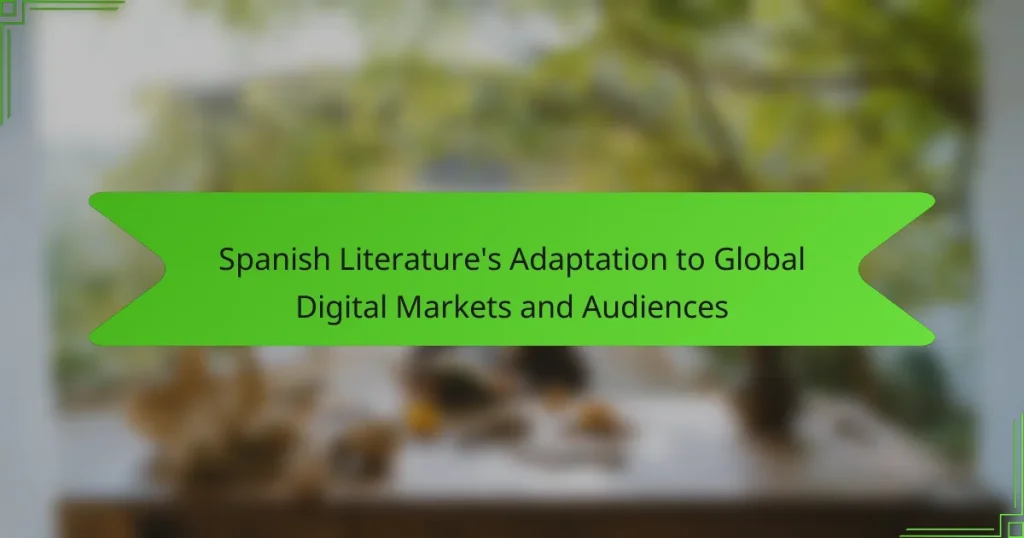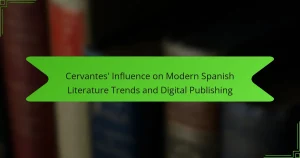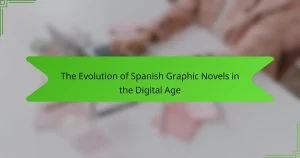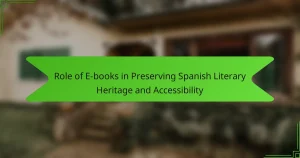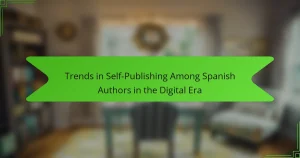Spanish literature is adapting to global digital markets, enhancing accessibility and engagement. Authors are embracing e-books, audiobooks, and interactive formats to reach wider audiences. The transition challenges traditional publishing models and fosters cultural exchange. Innovative marketing strategies, including social media engagement, are crucial for overcoming visibility and language barriers.
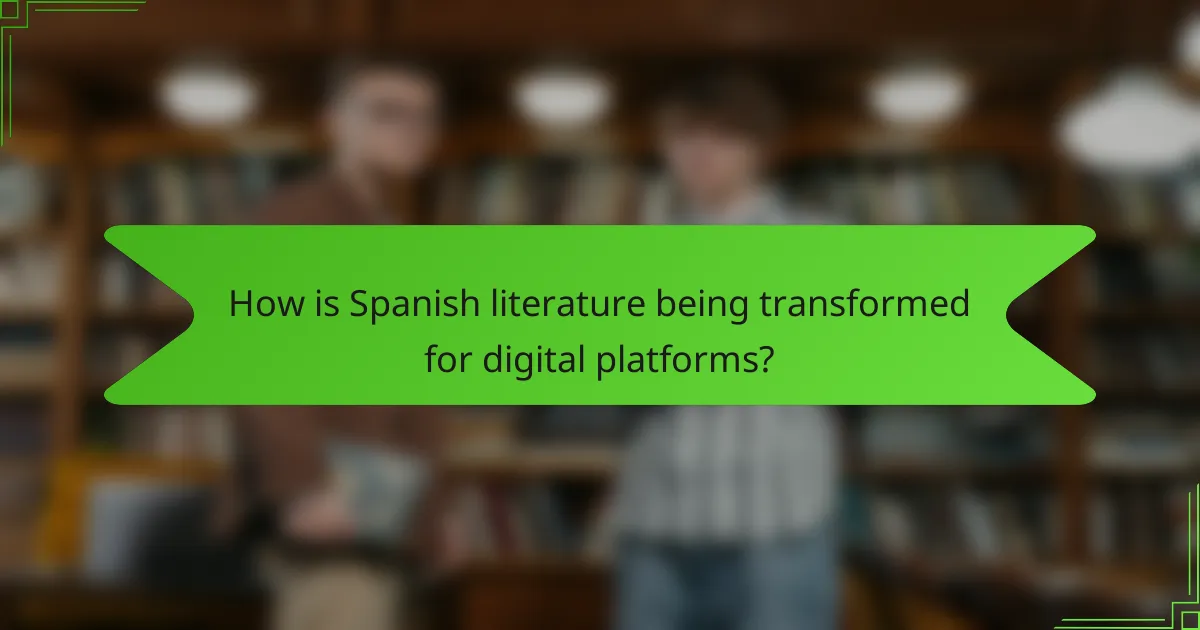
How is Spanish literature being transformed for digital platforms?
Spanish literature is evolving for digital platforms by embracing multimedia formats and global accessibility. Authors are utilizing e-books, audiobooks, and interactive storytelling to reach wider audiences. This transformation allows for innovative narratives and diverse voices, enhancing engagement. As a result, Spanish literature’s digital presence is expanding, appealing to readers worldwide.
What are the key digital formats for Spanish literary works?
Key digital formats for Spanish literary works include eBooks, audiobooks, online articles, and interactive narratives. These formats enhance accessibility and engagement, catering to diverse global audiences. eBooks allow readers to enjoy traditional texts digitally, while audiobooks provide an immersive experience. Online articles and interactive narratives offer innovative ways to present stories, appealing to younger readers. Transitioning to these formats ensures Spanish literature reaches wider audiences and adapts to changing consumption habits.
Which platforms are most popular for Spanish literature in global markets?
The most popular platforms for Spanish literature in global markets include Amazon, Google Play Books, and Apple Books. These platforms provide extensive access to Spanish literary works, catering to diverse audiences.
Amazon dominates the e-book market, offering a vast selection of Spanish titles. Google Play Books allows users to purchase and read books across devices, promoting accessibility. Apple Books integrates seamlessly with Apple devices, appealing to loyal customers.
Social media platforms like Instagram and Facebook also play a role in promoting Spanish literature, with authors and publishers engaging readers through targeted campaigns. Online book clubs and literary forums further enhance community interaction around Spanish literature.
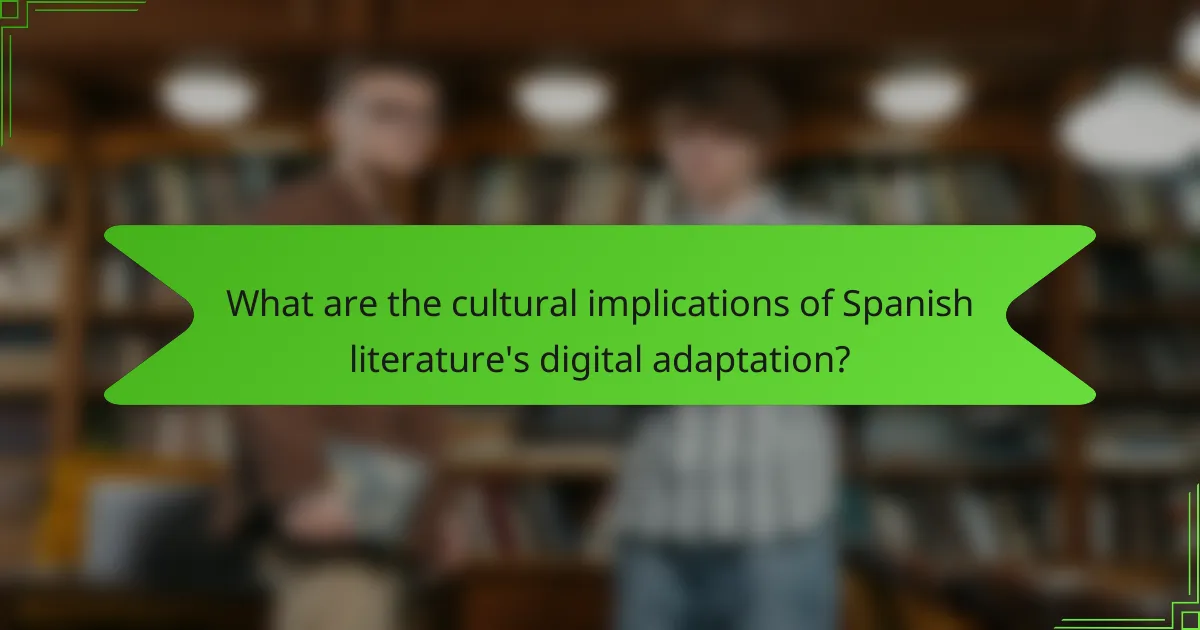
What are the cultural implications of Spanish literature’s digital adaptation?
Spanish literature’s digital adaptation significantly influences cultural perceptions and accessibility. The transition to digital formats broadens the audience, allowing diverse interpretations and global engagement. This adaptation fosters a dynamic exchange of ideas, enriching cultural dialogues. Additionally, it challenges traditional publishing models, prompting innovative storytelling methods. The unique attribute of interactivity in digital literature enhances reader involvement, making cultural narratives more relatable. As a result, Spanish literature gains visibility, impacting cultural identity and fostering cross-cultural connections.
How do regional audiences engage with Spanish literature online?
Regional audiences engage with Spanish literature online through diverse platforms and formats. Social media, blogs, and digital libraries facilitate access, fostering a global community.
Spanish literature’s adaptation includes e-books, audiobooks, and online discussions. These formats cater to varied preferences, enhancing reader interaction. For instance, Spanish authors leverage platforms like Wattpad and Instagram to connect with younger audiences.
Engagement metrics reveal significant interest; online book clubs and forums have surged, indicating a shift in how literature is consumed. This trend highlights the importance of digital presence for Spanish literature in global markets.
Moreover, unique attributes such as bilingual content and interactive storytelling enhance accessibility, attracting a broader audience. Adaptations of classic works into modern contexts resonate well, bridging cultural gaps.
What role does social media play in promoting Spanish authors?
Social media significantly enhances the visibility of Spanish authors in global markets. It facilitates direct engagement between authors and readers, fostering community and discussion around their works. Platforms like Twitter and Instagram allow authors to share insights, promote new releases, and connect with a wider audience. This interaction often leads to increased book sales and broader recognition beyond Spanish-speaking populations. Additionally, social media serves as a platform for literary events and virtual book tours, making literature more accessible. The unique attribute of real-time feedback from readers further enriches this dynamic, allowing authors to adapt their outreach strategies effectively.
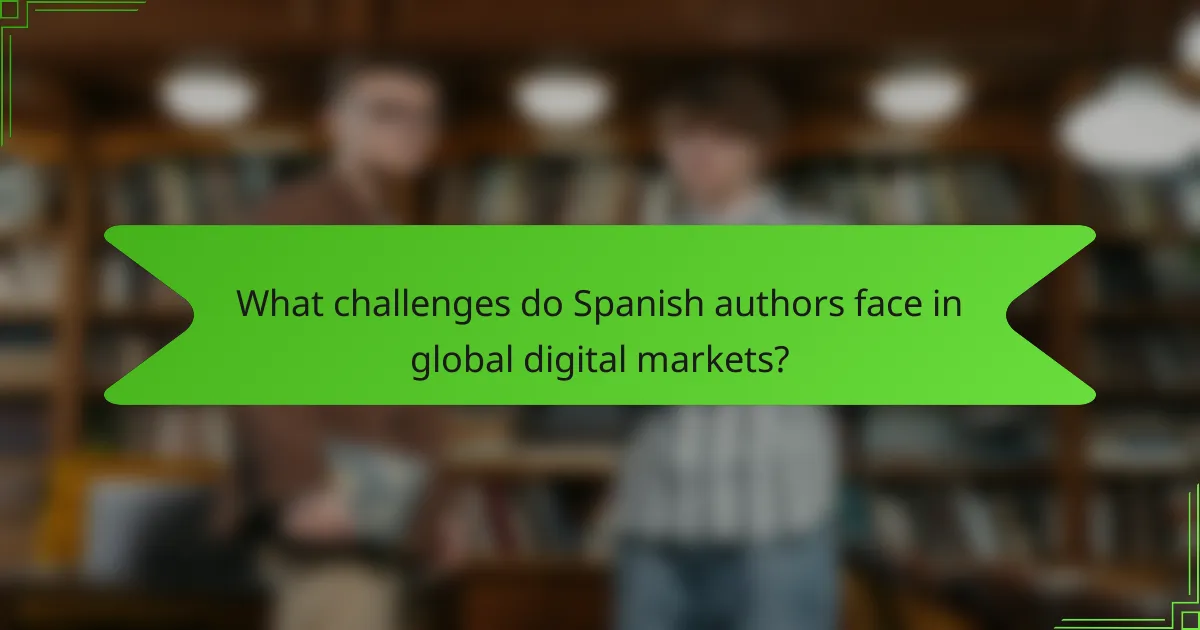
What challenges do Spanish authors face in global digital markets?
Spanish authors face significant challenges in adapting to global digital markets, including visibility, cultural barriers, and language limitations. These factors hinder their ability to reach wider audiences.
Visibility is a major issue, as countless authors compete for attention in crowded online platforms. Cultural barriers also play a role, as different cultural contexts may affect content reception. Language limitations restrict access to non-Spanish speaking markets, impacting potential readership and sales.
Moreover, the rapid evolution of digital technology requires authors to continuously adapt their marketing strategies. They must engage with social media and digital publishing trends to remain relevant.
As a result, Spanish authors must navigate these complex challenges to successfully establish their presence in global digital markets.
How do copyright issues affect the distribution of Spanish literature?
Copyright issues significantly hinder the distribution of Spanish literature in global digital markets. These legal constraints limit access and adaptation of works, impacting authors’ visibility and revenue. The complexity of copyright laws varies by country, creating barriers for both local and international publishers. Additionally, unauthorized translations and adaptations can undermine authors’ rights, leading to financial losses. As a result, Spanish literature struggles to reach broader audiences despite its rich cultural value.
What are the barriers to entry for new Spanish authors in digital spaces?
New Spanish authors face several barriers in digital spaces. Limited visibility on global platforms restricts audience reach. Language barriers can hinder engagement with non-Spanish speakers. Additionally, established authors dominate market share, making it difficult for newcomers to gain traction. Financial constraints may prevent effective marketing strategies, further complicating their entry.
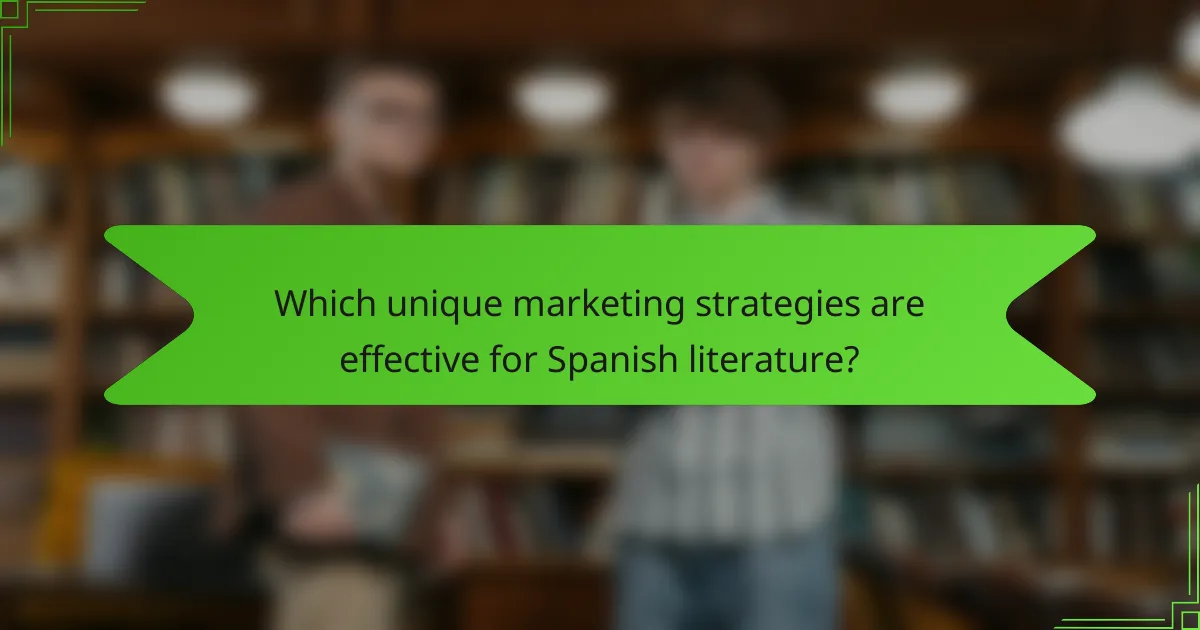
Which unique marketing strategies are effective for Spanish literature?
Innovative marketing strategies for Spanish literature include leveraging social media platforms, creating engaging content, and collaborating with influencers. These approaches effectively reach global audiences and adapt to digital trends. For example, using platforms like Instagram and TikTok allows authors to showcase their work in visually appealing formats, increasing visibility. Additionally, virtual book tours and online literary events foster community engagement while expanding readership. Emphasizing unique cultural narratives enhances relatability and attracts diverse audiences.
How can authors leverage local cultural festivals for online visibility?
Authors can leverage local cultural festivals to enhance their online visibility by engaging with diverse audiences and promoting their work. Participating in these festivals allows authors to connect with local communities, showcase their literature, and gain access to broader digital platforms.
Festivals often feature social media campaigns that authors can utilize for exposure. By collaborating with festival organizers, authors can create content that highlights their work while aligning with the festival’s themes. This strategy not only amplifies their reach but also fosters a sense of community around their literature.
Additionally, authors can host virtual events or live readings during these festivals, attracting online viewers and potential readers. Engaging with audiences through interactive sessions enhances their visibility and builds a loyal following.
Finally, authors can collect feedback and insights from festival attendees, informing their writing and marketing strategies. This data-driven approach allows authors to adapt their work to better suit global digital markets while maintaining cultural relevance.
What innovative collaborations are emerging in the Spanish literary scene?
Innovative collaborations in the Spanish literary scene are increasingly focused on digital platforms and international outreach. Authors are partnering with tech companies to create interactive e-books and multimedia storytelling experiences. These collaborations enhance reader engagement and expand market reach. For instance, Spanish writers are joining forces with digital publishers to adapt their works for global audiences, utilizing social media for promotion. This trend fosters cultural exchange and introduces Spanish literature to diverse demographics, enhancing its global footprint.
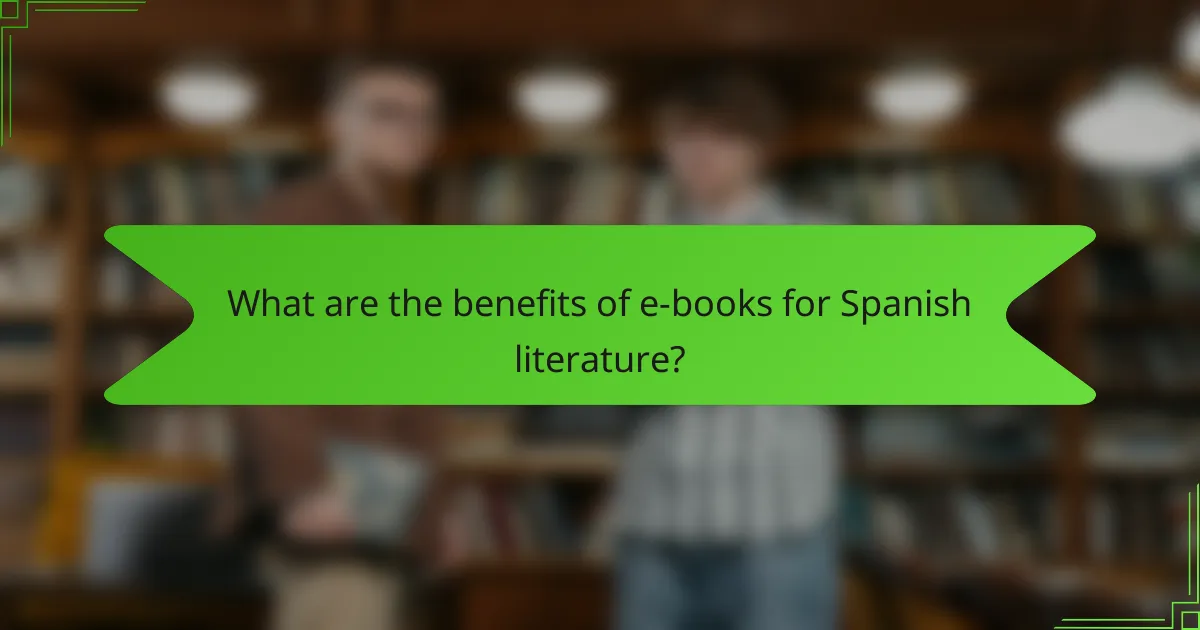
What are the benefits of e-books for Spanish literature?
E-books enhance access to Spanish literature, enabling wider audience reach and fostering cultural exchange. They offer convenience through portability and instant availability, appealing to modern readers. E-books often include interactive features, such as multimedia content, enriching the reading experience. Additionally, they can be more affordable, making literature accessible to diverse demographics.
How do e-books enhance accessibility for diverse audiences?
E-books significantly enhance accessibility for diverse audiences by providing instant access to a wide range of Spanish literature. They offer features like adjustable text size, audio options, and translations, which cater to varying reading abilities and preferences. E-books also eliminate geographical barriers, allowing global audiences to access works that may not be available in their local markets. This adaptability fosters inclusivity and promotes cultural exchange.
What are the environmental impacts of digital versus print literature?
Digital literature has a lower environmental impact than print literature due to reduced resource consumption. Digital formats eliminate paper production, which requires trees, water, and energy. Additionally, e-books reduce transportation emissions associated with physical books. However, the energy consumption of digital devices and data centers must be considered.
The carbon footprint of producing a printed book is significantly higher than that of a digital equivalent. For instance, a printed book can generate around 7.5 kg of CO2 emissions, while reading an e-book on a device may generate about 0.5 kg over its lifetime.
As a result, transitioning to digital literature can significantly decrease deforestation and pollution. This shift aligns with global sustainability efforts, promoting broader access to Spanish literature in international markets while addressing environmental concerns.
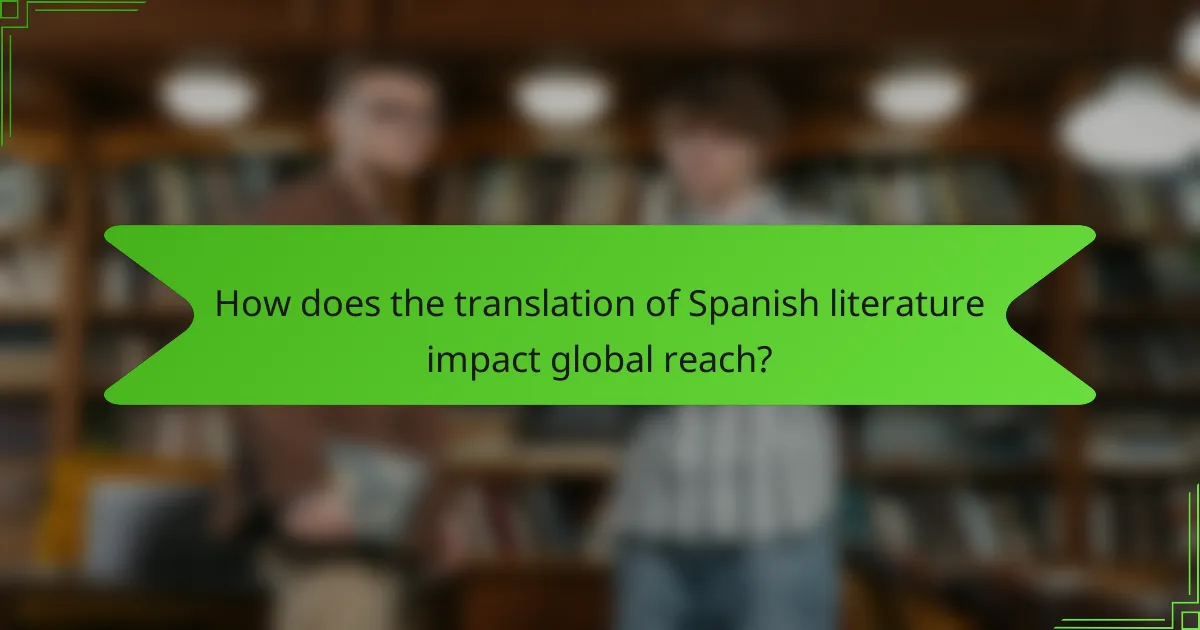
How does the translation of Spanish literature impact global reach?
The translation of Spanish literature significantly enhances its global reach by making it accessible to diverse audiences. Translated works allow readers worldwide to engage with Spanish narratives, themes, and cultural nuances.
Digital platforms amplify this effect, enabling instant access to translated texts. E-books and online literature forums connect Spanish authors with international readers, facilitating cultural exchange. For instance, the rise of literary translations has led to increased sales of Spanish novels in markets like the United States and the United Kingdom.
Moreover, the adaptation of Spanish literature to global digital markets fosters collaboration among translators, authors, and publishers. This collaboration results in innovative marketing strategies that further promote Spanish literature globally. As a result, the impact of translation extends beyond mere accessibility; it cultivates a richer, more diverse literary landscape.
What are the challenges of translating cultural nuances?
Translating cultural nuances presents significant challenges in adapting Spanish literature for global digital markets. These challenges include maintaining authenticity, conveying idiomatic expressions, and addressing cultural references that may not resonate with international audiences.
Additionally, different interpretations of tone and context can lead to misunderstandings. For instance, humor in Spanish literature often relies on cultural context that may be lost in translation. As a result, translators must balance fidelity to the original text with accessibility for new readers.
Moreover, the digital landscape requires adaptation to various formats and platforms, which can further complicate the preservation of cultural nuances. The unique attributes of Spanish literature, such as its rich historical context and regional dialects, can be particularly difficult to convey in a globalized format.
How do translated works influence perceptions of Spanish literature?
Translated works significantly shape perceptions of Spanish literature by broadening its reach and cultural resonance. They introduce diverse audiences to unique narratives and themes, enhancing global appreciation. For instance, translations can highlight the emotional depth of Spanish prose, fostering connections across cultures. This adaptability in digital markets allows Spanish literature to thrive, attracting readers who may not be familiar with the original language. As a result, translated works serve as vital conduits for cultural exchange, enriching the literary landscape worldwide.
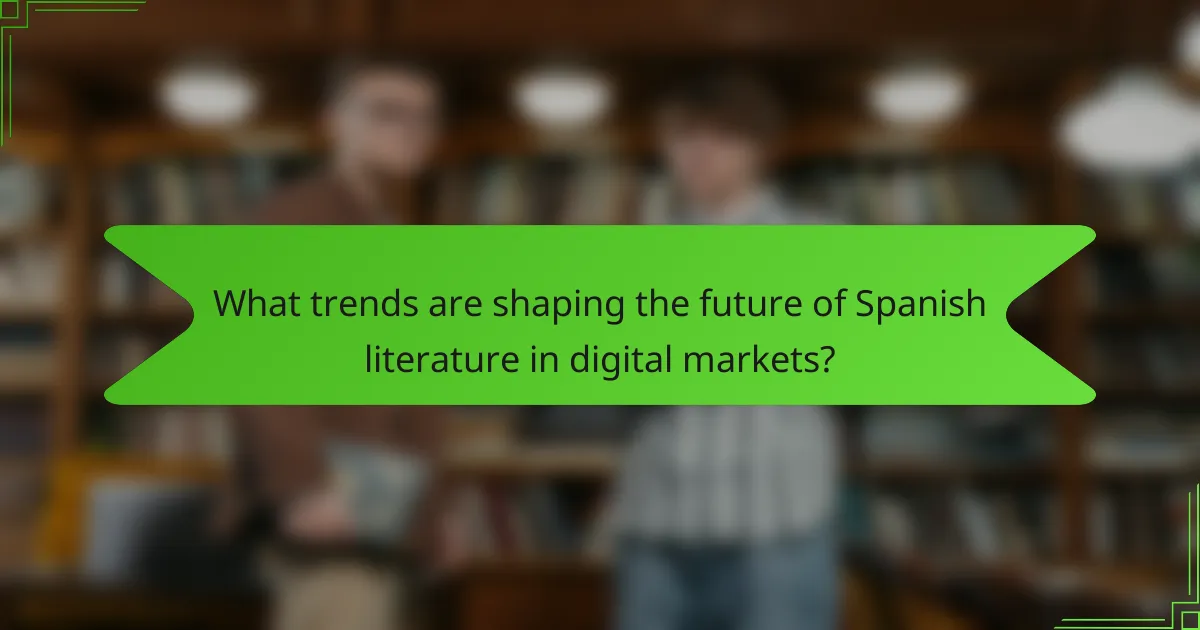
What trends are shaping the future of Spanish literature in digital markets?
Spanish literature is evolving rapidly in digital markets, driven by accessibility and globalization. The rise of e-books and online platforms allows Spanish authors to reach wider audiences. Innovative storytelling techniques, such as interactive narratives, are gaining traction. Additionally, social media enables direct engagement between writers and readers, fostering community and feedback. The demand for diverse voices is increasing, encouraging a broader representation of cultures within Spanish literature. As a result, traditional publishing models are being challenged, leading to new opportunities for emerging authors.
How is technology influencing storytelling in Spanish literature?
Technology is transforming storytelling in Spanish literature by enabling new forms of narrative expression and wider audience reach. Digital platforms allow authors to experiment with multimedia elements, enhancing traditional storytelling methods. For instance, e-books and interactive websites provide immersive experiences that engage readers in novel ways. Additionally, social media facilitates direct interaction between writers and audiences, fostering a global community. This shift not only broadens the market for Spanish literature but also influences themes and styles, as authors adapt to diverse cultural contexts and preferences.
What emerging genres are gaining traction among Spanish authors?
Emerging genres gaining traction among Spanish authors include speculative fiction, urban fantasy, and autofiction. These genres reflect cultural shifts and resonate with global digital audiences. Speculative fiction often explores societal issues through imaginative narratives. Urban fantasy incorporates contemporary settings, blending magic with everyday life. Autofiction allows authors to blur the lines between reality and fiction, enhancing personal storytelling.
What best practices should authors follow to succeed in digital markets?
Authors should focus on understanding digital platforms and audience preferences to succeed in global markets. They must adapt their content for diverse formats, such as e-books and audiobooks, to reach wider audiences. Engaging with social media and online communities enhances visibility and connection with readers. Collaborating with digital marketers can optimize promotional strategies, ensuring effective outreach. Continuous learning about digital trends is crucial for maintaining relevance in a rapidly evolving landscape.
